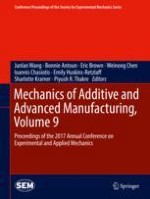2018 | Book
Mechanics of Additive and Advanced Manufacturing, Volume 9
Proceedings of the 2017 Annual Conference on Experimental and Applied Mechanics
Editors: Prof. Junlan Wang, Dr. Bonnie Antoun, Dr. Eric Brown, Weinong Chen, Prof. Ioannis Chasiotis, Emily Huskins-Retzlaff, Dr. Sharlotte Kramer, Dr. Piyush R. Thakre
Publisher: Springer International Publishing
Book Series : Conference Proceedings of the Society for Experimental Mechanics Series
